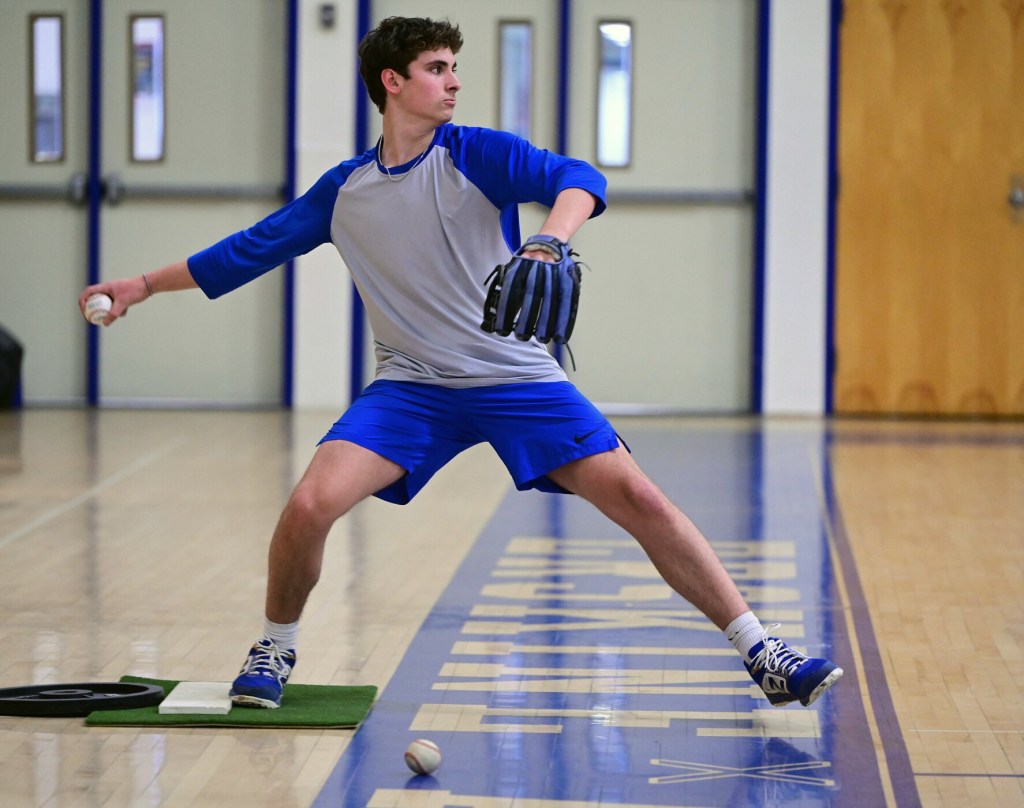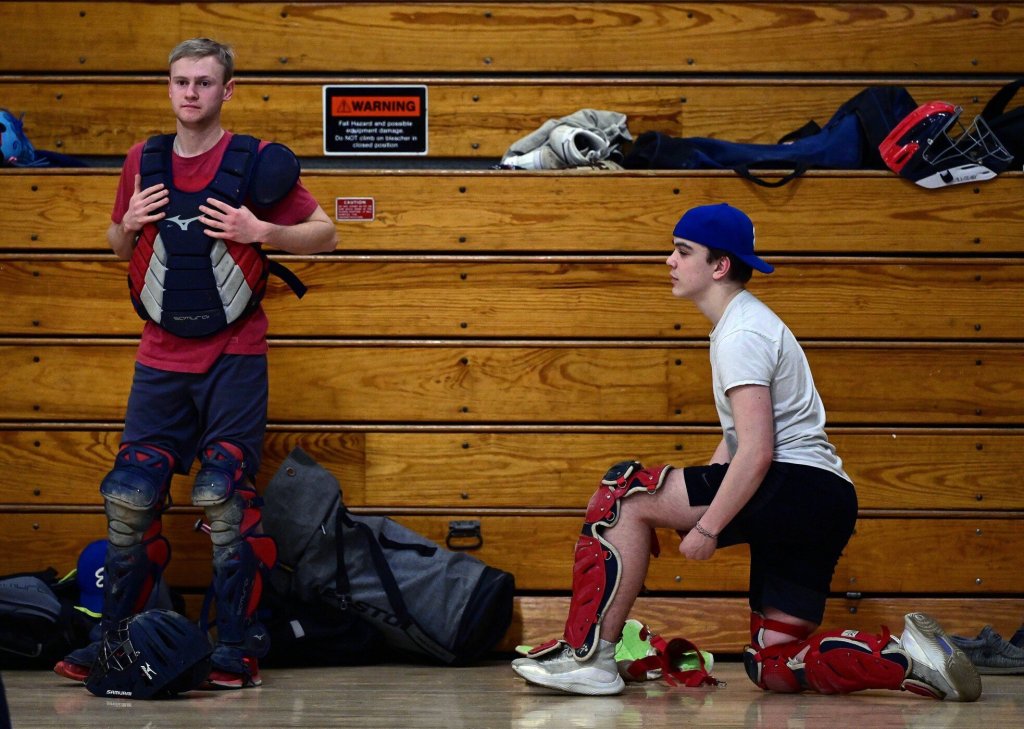SOUTH CHINA — It would be foolish to say pitching, known to produce various arm injuries at the high school level, is easy for baseball and softball players. There is, though, a certain edge the person on the rubber will always have.
By a mere matter of science, the edge is usually going to go to the person whose job it is to hurl the ball at high speeds than the one who has to swat that ball. That’s only the case, though, if the pitcher and catcher are on the same page — and that’s one reason this week is so crucial.
Monday marked the first day baseball and softball pitchers and catchers were eligible to begin conditioning drills for the upcoming 2023 season. It’s a week that allows players at those positions to build arm strength, sure, but also for them to build the relationships that can make or break entire seasons.
“With how the season breaks down, it’s really important to be able to build that right away,” said Maranacook head coach Eric Brown. “You have to have that extra week where they can throw and get a feel for each other because, once they get into next week, you’re focused more on fine-tuning hitting, defense and all the aspects of the game.”
It’s quite common for teams to enter a season needing to break in new starting pitchers, a new starting catcher or even both. Sure, there are some fortunate enough to bring back both battery components, but for the majority of squads, there’s work to be done to ensure a partnership that includes at least one newcomer is in sync.
One such team is Erskine Academy, which returns its full pitching staff but must find a new catcher. One of the Eagles’ very first tasks, head coach Colby Foster said, will be to find out how well some of the new players competing for the starting catcher job match up with their pitching partners.
“We’re bringing a few guys, and this week is huge because it gives them that opportunity to work with that pitching staff,” Foster. “I have a philosophy where I like my catcher to call the game if he’s comfortable doing that, and that’s something that takes some time, so that extra week does help.”
Yes, the catcher often knows just as well a pitcher does what pitches are ideal to throw in a given situation. The person behind the plate must know pitchers’ tendencies — their speeds and movements as well as what pitches they excel at throwing and their paces on the mound.

Erskine Academy catchers Sam Boynton, left, and Landen Hayden put on their gear before working with pitchers during a baseball team practice for pitchers and catchers Monday in South China. Rich Abrahamson/Morning Sentinel
“As battery-mates, it’s just you and him, and you’ve got to get that chemistry down,” said Sam Boynton, one of Erskine’s prospective new catchers. “When you agree on a pitch, that’s a group decision, and you need them to agree with you. That trust starts there, so it’s very important.”
Being a pitcher, of course, puts a lot of pressure on a young arm. It’s a violent torquing motion that requires great strength at particular points in the biceps, deltoids and brachialis, just to name a few of the arm muscles that need to be properly conditioned to generate proper throwing power.
Catchers, though, are no less in need of having strong arms of their own. Even if their throws back to the pitcher aren’t as powerful or violent, they can still add up when done more than 100 times a game. Being able to hop up from a crouching position to catch stealing baserunners is also something that can tax untrained arms.
“(Catcher) is usually that first position where you see someone say, ‘Coach, I’m feeling sore today; I’m not going to be able to make those throws,’” Foster said. “If you’re going to avoid that, you’ve got to get that arm strength built up. It’s not just being able to throw harder; it’s about building endurance.”
• • •

Hall-Dale catcher Zoe Soule plays in a game against Madison last season in Farmingdale. Soule returns behind the plate for the Bulldogs. Joe Phelan/Kennebec Journal
The Hall-Dale softball pitchers and catchers hit the gym for the first time also Monday. The Bulldogs — the two-time defending Class C champions — have carried one of the top catchers in the state in junior Zoe Soule. Entering her third season as a starter, there’s no question who the leader is behind the plate for head coach Steve Acedo.
“To me, she’s the best catcher (in the state),” Acedo said. “She knows what she’s doing back there. She calls about 95 percent of the game back there herself. She reads the hitters, knows what she wants thrown. If there’s something we want thrown, she adjusts to that. … She’s a rock back there, and to me, that means everything.”
To stay healthy and build up her arm strength, Soule said she mixes weight training with throwing throughout the year.
“I’m always throwing once a week,” Soule said. “I always make it a point for myself to stretch every day. I work out in the offseason to build up my arm strength, because I know how important it is. Pop time (how quickly a catcher can make a throw to a base) is important. I build myself up more during the offseason than in-season, because you don’t want to hurt your arm in-season.”
Soule said she incorporates long toss and weight lifting to stay sharp in the offseason.
“Long toss, just throwing every week,” Soule said. “Weight lifting every offseason. Not very heavy though.”
“We do a lot of conditioning, a lot of throw downs,” Acedo said. “We’ve got three or four (catchers) in there doing the drills. They’re staying in shape with blocking (pitches) and throwing down (to second base). They have their own little workout from everyone else after stretching. They should be ready.”
Gardiner softball returns as the defending Class B champion. The Tigers are spoiled behind the dish this season. Seniors Dewey Clary, Dakota Lovely and Kylie Boardman will see time at catcher this season.
“It’s a good and a bad thing, because I have all senior catchers,” Gardiner head coach Ryan Gero said. “Right now, we’re developing some freshmen catchers. Recently, I told them in the meeting, ‘If you want to play a lot, I suggest you play catcher. Because after this year… Just take your time, enjoy it and learn.’”
Lovely (skiing) and Boardman (hockey) both participate in winter sports known for building leg strength, a key component in getting conditioned for catching.
“(Hockey) helps so much,” Boardman said. “Everything in hockey involves strides. It gets my quads (fired up).”
“When I come back (for softball), my legs don’t kill as much as other catchers do,” Lovely said. “You have to build (leg muscles up), so now I’m (ready) a little quicker and maybe have an advantage.”
Gero said arm strength is a key component in the success of his catchers.
“It’s huge, it’s very huge,” Gero said. “What we do this week, I tell my catchers, ‘When you’re throwing back to the pitchers this week, you’re throwing lobs. We’re going to take care of our arms. We spend all week lifting. … Not trying to build muscle mass, but to build up our arm strength to do that much throwing.
“(Catchers) throw just as much, if not more so, than pitchers,” Gero said. “When plays happen, they’ve got to throw from home to second, or home to first. It’s a little different. But the catchers I have are experienced, they know our system, they know what they need to do and they just do it.”
Send questions/comments to the editors.










